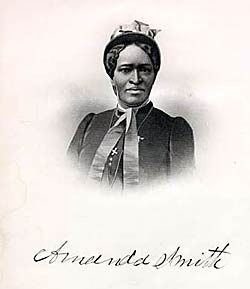Readings:
This commemoration is a 2018 addition to A Great Cloud of Witnesses.
Return to Lectionary Home Page
Webmaster: Charles Wohlers
Last updated: 29 Dec. 2018
AMANDA BERRY SMITH
PREACHER AND MISSIONARY, 1915
 Amanda Berry Smith (January 23, 1837 – February 24, 1915) was a former slave who funded The Amanda Smith Orphanage and Industrial Home for Abandoned and Destitute Colored Children. She was referred to as "God's image carved in ebony".
Amanda Berry Smith (January 23, 1837 – February 24, 1915) was a former slave who funded The Amanda Smith Orphanage and Industrial Home for Abandoned and Destitute Colored Children. She was referred to as "God's image carved in ebony".
Smith was born to slaves in Long Green, Maryland. Her father was devoted to the goal of freedom. After first purchasing his freedom, he made it his mission to buy his family's. After his family's freedom was secured, the Smiths settled in Pennsylvania.
As an adult, Amanda worked hard as a cook and a washerwoman to provide for herself and her daughter after her husband was killed in the American Civil War. By the time Smith was thirty-two, she had lost two husbands and four of her five children. Attending religious camp meetings and revivals helped Smith work through her grief and avoid depression. She immersed herself in the African Methodist Episcopal (AME) Church. Prayer became a way of life for her as she trusted God for shoes, the money to buy her sister's freedom, and food for her family.
She became well known for her beautiful voice and inspired teaching and hence, opportunities to evangelize in the South and West opened up for her. In 1878, Smith arranged for her daughter, Mazie, to study in England. The two traveled overseas and stayed in England for two years. She next traveled to and ministered in India, where she stayed for eighteen months.Smith then spent eight years in Africa, working with churches and evangelizing. She traveled to Liberia and West Africa. Smith also expanded her family by adopting two African boys.
Amanda funded The Amanda Smith Orphanage and Industrial Home for Abandoned and Destitute Colored Children. It was an institution for the poor and friendless colored children. Located in North Harvey, a suburban neighborhood in Chicago, the orphanage opened on June 28, 1899. The institution provided a home for children to become self-reliant. Amanda traveled many states to help gather money to support her work. To raise funds for the initial costs, Smith enlisted Methodist interracial cooperation across the country. She was dedicated and put forth a lot of energy for the home. However, she soon met conflict with the orphanage due to many problems including financial difficulties, a fire that destroyed the building, conflict between Smith and the staff, complaints from neighbors, and failed inspections by the orphan home investigators. The orphanage finally closed in 1917.
In the early years of the 20th century, Amanda Smith continued to visit various countries and gained a reputation as "God's image carved in ebony." She retired to Sebring, Florida in 1912 due to failing health.Her autobiography was published in 1893, titled An Autobiography, The Story of the Lord's Dealing with Mrs. Amanda Smith, the Colored Evangelist Containing an Account of her Life Work of Faith, and Her Travels in America, England, Ireland, Scotland, India, and Africa, as An Independent Missionary.
more at Wikipedia